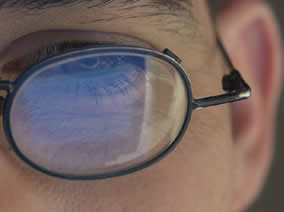 Tired, sore, scratchy eyes? Headaches? Blurry vision? You could be suffering from eye strain. Maire Bonheim explains how you can do something about it!
Tired, sore, scratchy eyes? Headaches? Blurry vision? You could be suffering from eye strain. Maire Bonheim explains how you can do something about it!
Eye strain getting you down? You’re not alone - itchy, aching eyes and even muscle spasms in the eyes and eyelids are common among office workers, especially those who spend long hours in front of a computer screen. But eye strain can be avoided by making small, simple changes to the way you sit and work.
Eye strain is usually caused by spending too much uninterrupted time squinting at a screen or reading documents. When your eyes are focused on your PC, the inner muscles tighten and can become strained and painful, much in the way any muscle would if it was tensed in one position for a long period of time without a rest.
This effect is worsened by factors such as bad lighting, for example fluorescent lights, bad posture, looking at the screen from a difficult angle, working long hours staring at a computer screen or documents without breaks, having poor eyesight (perhaps without realising it) and not using adequate glasses or contact lenses, reading or working from a PC screen with colours or fonts that are difficult to read and staring too close to the screen or page.
What You Can Do
• Get your eyes checked to ensure you’re using the right prescriptive glasses or contacts for your eyes – you may find you need to use glasses when working at a PC but not for any other activities.
• Reposition your desk and PC at a comfortable height and angle to make reading easy and your body comfortable – your eyes should be level with or just above the top of the computer screen so you look slightly downwards at your work.
• Make sure your desk has adequate lighting that does not create a glareyou’re your screen or shine into your eyes (so don’t place your PC in front of a window), and sit upright looking at the screen straight-on.
• If necessary, you can get a non-glare filter for the computer screen to reduce glare
• Take regular breaks to stretch, get up and move around, or simply look away from your screen and watch something further away to rest your eye muscles. Do this at least once every half hour to allow your eyes to refocus and relax.
• Drink lots of water to prevent headaches and dry eyes.
• Keep the room hydrated by working with a window open or use a humidifier.
• Try to alternate computer work with other jobs to prevent too much time staring at the screen.
• Use a document holder to place any documents you are using at the same level as the screen – this prevents your eyes having to constantly adjust to focus on different angles and distances.
Dry Eye
Make sure you don’t squint at the computer screen, as most people do unconsciously in order to focus objects more clearly and reduce the brightness of a glare on the screen. Studies show that even slight squinting cuts the amount of times you blink in half, which can cause painful and irritating dry eye, characterised by aching or burning eyes that feel dry and scratchy.
"Blinking rewets the eyes. So if your job requires a lot of reading or other visually intense work, you may be blinking far less than normal, which may cause eye strain and dry eye," says Dr James Sheedy, professor of optometry at Ohio State University in the US.
You can treat dry eye to some extent with eye drops, but it’s best to fix the cause – that means re-positioning your computer to make it easily visible and free of glare, and making font bigger for easier reading. It’s also important to look at your posture – if you’re resting your chin on a hand, for example, that probably means you’re squinting to see the screen.